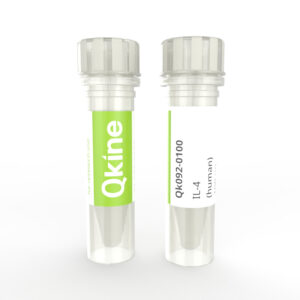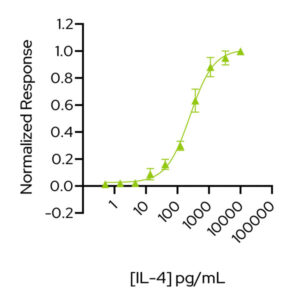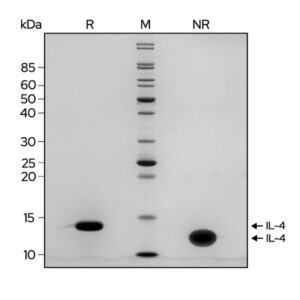Currency



Recombinant human IL-4 protein (Qk092)
Interleukin-4 (IL-4) is a pleiotropic, immune-modulatory cytokine that is secreted primarily by mast cells, T-cells, eosinophils, and basophils. IL-4 plays a crucial role in hematopoiesis, the regulation of antibody production, the stimulation of activated B cell and T cell proliferation, and the differentiation of B cells into plasma cells
Human IL-4 has a molecular weight of 15.1 kDa. This protein is animal origin-free, carrier-free and tag-free to ensure its purity with exceptional lot-to-lot consistency. Qk092 is suitable for the culture of reproducible and high-quality stem cells and other relevant cells.
Orders are typically shipped same or next day (except Friday).
Easy world-wide ordering, direct or through our distributors.
1000µg will be despatched as 2 x 500µg
Fast and free shipping.
Buy online with secure credit card or purchase order.
For any questions, please email info@clinisciences.com
- Description
Summary
High purity human protein (Uniprot number: P05112)
>98%, by SDS-PAGE quantitative densitometry
Source: Expressed in E. coli
15.1 kDa monomer
Animal origin-free (AOF) and carrier protein-free
Manufactured in Cambridge, UK
Lyophilized from acetonitrile/TFA
Resuspend in water at >100 µg/mL, prepare single-use aliquots, add carrier protein if desired, and store frozen at -20oC or -80oC
Featured applications
Stimulation of activated B cell proliferation
Stimulation of activated T cell proliferation
Differentiation of B cells into plasma cells
- Adaptive immunity regulator
- Antibody regulation
- Lymphoid differentiation
Alternative protein names
Interleukin-4
B-cell stimulatory factor 1 (BSF-1)
Binetrakin
Lymphocyte stimulatory factor 1
Pitrakinra
Species reactivity
human
species similarity:
mouse – 39%
rat – 38%
porcine – 59%
bovine – 55%
Frequently used together
Recombinant human GM-CSF protein (Qk076)
Recombinant human M-CSF protein (Qk075)
Bioactivity
IL-4 activity is determined using proliferation of TF-1 human myeloid leukemia cells. EC50 = 235 pg/mL (16 pM). Cells are treated in triplicate with a serial dilution of IL-4 for 72 hours. Cell viability is measured using the CellTiter-Glo (Promega) luminescence assay. Data from Qk092 lot #204598.
Purity
Recombinant IL-4 migrates as a major band at approximately 14 kDa in non-reducing (NR) and at approximately 12.5 kDa in reduced (R) conditions. No contaminating protein bands are present. The purified recombinant protein (3 µg) was resolved using 15% w/v SDS-PAGE in reduced (+β-mercaptoethanol, R) and non-reduced conditions and stained with Coomassie Brilliant Blue R250. Data from Qk092 batch #204598.
Further quality assays
Mass spectrometry, single species with the expected mass
Endotoxin: <0.005 EU/μg protein (below the level of detection)
Recovery from stock vial: >95%
We are a company founded and run by scientists to provide a service and support innovation in stem cell biology and regenerative medicine. All our products are exceptionally high purity, with complete characterisation and bioactivity analysis on every lot.
Qkine IL-4 is as biologically active as a comparable alternative supplier protein
Stimulation of proliferation of TF-1 cells with Qkine IL-4 (Qk092, green) and alternative supplier IL-4 (Supplier B, black). Cells were treated in triplicate with a serial dilution of IL-4 for 72 hours and proliferation measured using the CellTiter-Glo (Promega) luminescence assay.
Protein background
Interleukin 4 (IL-4) is an important signaling molecule within the immune system, playing multiple roles in orchestrating immune responses and maintaining immune homeostasis. IL-4 is primarily produced by immune cells, including mast cells, T helper 2 (Th2) cells, eosinophils, and basophils, and exerts its effects through interaction with its specific receptor, IL-4Rα and subsequent activation of downstream signaling pathways [1]. IL-4 plays a crucial role in hematopoiesis, the regulation of antibody production, the stimulation of activated B cell and T cell proliferation, and the differentiation of B cells into plasma cells. IL-4 induces the expression of class II MHC molecules on resting B-cells and aids regulation of the low-affinity Fc receptor for IgE (CD23) expression on lymphocytes and monocytes [2].
IL-4 has a compact, globular fold stabilized by three disulfide bonds. IL-4 consists of a characteristic four-alpha helix bundle with a left-handed twist, along with a two-stranded anti-parallel beta-sheet [2-3]. This structural arrangement allows stability to IL-4 and also facilitates its interaction with its receptor, IL-4Rα. The receptor for IL-4, IL-4Rα, exists in three distinct complexes within the body, each playing a crucial role in mediating IL-4 signaling [4]. Type 1 receptors consist of the IL-4Rα subunit coupled with a common gamma chain, while type 2 receptors comprise the IL-4Rα subunit bound to IL-13Rα1. Type 1 receptors specifically bind IL-4, whereas type 2 receptors have the capacity to bind both IL-4 and IL-13, two cytokines with closely related functions. This differential receptor composition allows for nuanced regulation of immune responses depending on the specific ligands present [5].
IL-4 serves as a regulator of immune cell differentiation and activation. It promotes the differentiation of naive T cells into Th2 cells, which are crucial for orchestrating immune responses against extracellular pathogens and for mediating allergic reactions. Additionally, IL-4 stimulates the proliferation and activation of B cells, leading to the production of antibodies and the formation of memory B cells [8]. IL-4 plays a pivotal role in modulating macrophage polarization and the development of an alternative activation phenotype (M2) associated with tissue repair and resolution of inflammation [9].
In the context of disease, dysregulation of IL-4 signaling has been implicated in various immune disorders, including allergies, asthma, and autoimmune diseases. Enhanced IL-4 production or aberrant IL-4 receptor signaling can contribute to the pathogenesis of allergic inflammation and tissue damage. Therapeutic strategies aimed at targeting IL-4 or its receptor have shown promise in treating these conditions by modulating immune responses and dampening inflammation [8-10].
Background references
Additional resources
Our products are for research use only and not for diagnostic or therapeutic use. Products are not for resale.


